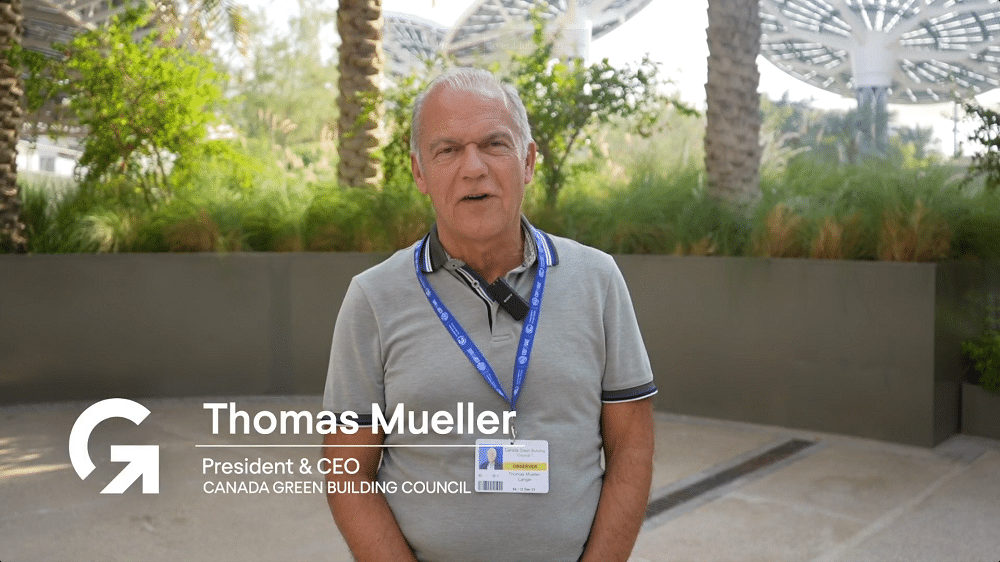COP28: What does it mean for Canada’s building sector?
Thomas Mueller on December 14, 2023
- Theme
- Advocacy
Recently, I had the opportunity to travel to Dubai in the United Arab Emirates to participate as an observer in the UN Climate Change Conference. It is the first time CAGBC has participated in what is described as the only multilateral decision-making forum on climate change with almost complete membership of every country in the world.
COP28 is the largest gathering of States, international organizations, and non-governmental organizations, having over 90,000 participating delegates or observers and more than 300,000 people expected to visit the public COP28 spaces. CAGBC attended also as a member of the World Green Building Council and the global BuildingToCOP coalition, which Cristina Gamboa, CEO of the WorldGBC, supported as our global ambassador.
Getting approved for observer status is a year-long process, so we were thrilled to have CAGBC represented by me, Chief Commercial Officer Brent Gilmour, and our Advisor for Advocacy and Government Affairs, Jean-Marc Fagelson.
With the release of the Global Stocktake, and first inclusion of language around transitioning from fossil fuels, there are some significant wins for the green building sector to focus on. According to the U.N., “the Global Stocktake is a critical turning point when it comes to efforts to address climate change – it’s a moment to take a long, hard look at the state of our planet and chart a better course for the future.”

Take aways for CAGBC members
The launch of the Buildings Breakthrough and the Cement and Concrete Breakthrough were pivotal for our sector. Canada co-chaired the Cement Breakthrough and was represented by Steven Guilbeault, Minister of Environment and Climate Change and by the head of the Canadian delegation at COP28, along with François-Philippe Champagne, Minister of Innovation, Science and Industry, and the Ambassador for Climate Change, Catherine Stewart.
Under the Buildings Breakthrough, led by France and Morocco with the support of the GlobalABC and the WorldGBC, 28 countries committed to making near-zero emission and resilient buildings the new normal by 2030, aligning with CAGBC’s strategic focus and efforts.

Minister Champagne introduced the Cement and Concrete Breakthrough initiative, a global effort to share best practices to decarbonize this vital sector. His speech highlighted the Heidelberg Materials’ net zero carbon capture and storage facility project in Alberta and Ambassador Stewart moderated a panel discussion on the opportunity.
Additionally, the Forest and Climate Leader’s Partnership (FCLP) on Greening Construction announced a coalition of 17 countries including Canada that committed to advancing policies and approaches that support low carbon construction and increase the use of wood from sustainably managed forests in the built environment by 2030.
Key trends to watch
Thanks to our work on Zero Carbon Building Standards and other carbon reduction initiatives, it’s clear that CAGBC is aligned with the solutions being discussed at the international level. We will continue to promote zero-carbon buildings and deep carbon retrofits to match the global necessity to eliminate operational emissions and reduce embodied carbon by 40 percent by 2030.
Other conversations at COP28 which will have an impact on the Canadian building sector include:
- Whole-life carbon which describes the combined total of embodied and operational emissions over the whole life cycle of a building is growing in significance. All carbon emissions from buildings need to be accounted for and reduced for the sector to reach its climate change targets.
- Nature-based solutions, driven by the new Taskforce on Nature-related Financial Disclosures, will require industry to limit impacts on ecosystems from development and to find ways to restore natural systems to protect biodiversity, promote carbon sequestration and increase resilience.
- At the end of COP, 198 countries called on transitioning away from fossil fuels for energy systems, and the adoption of clean energy by tripling renewable energy capacity and doubling the energy efficiency rate by 2030.
- Carbon disclosure and regulations: In side-events, we saw the prominent role of the International Sustainability Standards Board. Financial institutions are increasingly considering carbon as a value and are moving toward credible carbon accounting practices. For the real estate sector, this means that asset managers need to track carbon emissions alongside water, energy, and waste.
- Adaptation and resilience: companies are being pushed by the finance sector such as banks, insurance companies and investors to demonstrate that their buildings consider climate risks and opportunities in alignment with ESG requirements.
Advocating for the green building sector
CAGBC had also the opportunities to connect with Minister Champagne and Ambassador Stewart to discuss the importance of zero carbon buildings, low-carbon cement and concrete, and the important role industry will play in advancing these innovations.
These discussions and the Breakthrough Agendas validate CAGBC’s strategy to focus on transition planning at the building and portfolio level. Following COP, CAGBC will continue to advocate for a Green Buildings Strategy in Canada which is aligned with the international Buildings Breakthrough commitments.
To maintain momentum, we are looking forward to the first-ever Buildings and Climate Global Forum, to be held on 7-8 March 2024 in Paris, France. This forum will bring together ministers from around the world, as well as stakeholders across the building sector value chain, including local authorities, NGOs, and businesses.
Looking ahead
The toughest parts of the negotiations were clearly the phasing down/phasing out fossil fuels and the financing climate actions, particularly support for adaptation and resilience. With the mention of transitioning from fossil fuel (a first in 30 years of climate diplomacy), a step was taken to limit global warming. Unfortunately, the financial support on adaptation is postponed to next year’s discussions in Azerbaijan.
While the spectre of climate change and its impact on the planet and people remains dire, I left COP28 feeling more optimistic that progress is being made. While change is not happening at the scale and speed required to bend the emission curve downward, we did see many examples of practical, proven solutions being rolled out globally, clearly demonstrating a market shift towards low-carbon business practices. These solutions reflect a deep understanding that the path forward will require a holistic approach requiring the collaboration of government and business – the latter represented in significant numbers for the first time.
